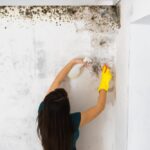From a small leak to a record-breaking rainstorm, even the smallest amounts of water that seeps into your home is unpleasant. Although a small puddle may seem easy to clean up, it is what can happen if it is not dried out thoroughly that will wreak havoc on your home.
If you’ve been face-to-face with flooding in your home before, you know how frustrating it can be trying to clean everything up. If this is your first time, the faster you can dry out the house, the better it will be in the end.
So, if you have found yourself in a wet situation, here are three critical steps you should take before doing anything else.
Assess the Situation
The first thing you want to do is assess the flood situation. If you had a small leak in the roof that let in only minimal amounts of water, chances are you can clean it up on your own. However, if your whole basement is flooded and you had to evacuate your home, your best bet is to hire a water damage restoration company.
When water stands for too long of time in the house, it starts to deteriorate everything around it. The structural integrity of the home can quickly become compromised. The water will damage any belongings that get in its way. However, one of the most challenging situations that are inevitable is mold growth. That is why you want to determine if the amount of water is beyond your capability, your safest method is to bring in the professionals.
Document Everything
Before you begin anything, go around and document everything you see in regards to the flood. Take photos, a video, and write out a detailed description of where the water is, how much you can see, what is all in the water, and any damage you come across. You are best to document even the tiniest aspect of the flood.
All of your documentation will come in handy when it is time to bring in the insurance company. The more evidence you can show of the flood, the better it will be for you when determining your insurance coverage.
Put on Personal Protective Equipment
There is a good chance you won’t know where that water came from and what is in it. Floodwater tends to have sewage and chemical contamination, all things you do not want to get on your body. Even after it is cleaned up, you still want to keep yourself protected in case you come across mold.
Put on waders or hip-length rubber boots to keep yourself dry. Rubber gloves will protect your hands, but you should still regularly wash your hands in between working. A respirator is a good idea to protect yourself from breathing in anything harsh.
After going through these three steps and have determined whether or not it is suitable (and safe) for you to begin the clean-up job, you’ll want to move as quickly as possible. The faster you can get the water out of your house, your chances of salvaging personal belongs increasing, and mold growth decreases.





